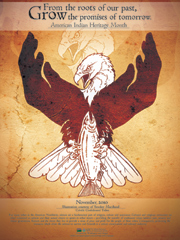
Artist Virgil “Smoker” Marchand, a member of the Colville Confederated Tribe, designed the artwork for the national American Indian Heritage Month Poster. The illustration depicts the transfer of traditional values between past, present and future gen
SPOKANE – A Colville Confederated Tribes (CCT) artist’s work is the featured illustration on this year’s American Indian Heritage Month poster produced by USDA’s Natural Resources Conservation Service (NRCS), the agency recently announced.
Virgil “Smoker” Marchand’s pen-and-ink illustration depicting the cultural significance of salmon appears on the poster that is being distributed to nearly 3,000 USDA offices throughout the nation – including the Caribbean and Pacific basins. Marchand, an accomplished artist in a wide range of media, is a member of the Arrow Lakes Band of the CCT.
Throughout November, American Indian Heritage Month is celebrated to recognize the intertribal cultures and to educate the public about the heritage, history, art, and traditions of American Indians and Alaska Natives. Each year, the NRCS creates a poster from a selected American Indian or Alaska Native artist to kickoff the heritage month celebration. 
“American Indian Heritage Month enhances our efforts to honor tribal sovereignty by working on a government-to-government basis with American Indians and Alaska Natives,” NRCS State Conservationist Roylene Rides at the Door said. ”We honor the rights of Indian tribes and work to protect and enhance tribal resources.”
Rides at the Door said that for many tribes in the American Northwest, salmon are a fundamental part of religion, culture and sustenance, and that cultural and religious ceremonies are often connected to salmon and their annual return to spawn in tribal waters.
“Mr. Marchand’s illustration depicts the transfer of traditional values between past, present and future generations,” she said, “and underscores why protecting the resources which allow the salmon to survive and flourish are important conservation and cultural endeavors.”




Comments are closed.